The Taroko Gorge is not Hualien's only canyon worth exploring. A scenic three-hour walk up the nearby Sanjhan River (三棧溪) takes you to the Golden Grotto (黃金峽谷), an awe-inspiring razor-thin canyon carved into the mountain's hard marble walls, culminating in the Inner Sanctum’s waterfall.
I had been waiting for years to visit this renowned destination, but was unwilling to try it on my own as it sounded too technical for someone without river tracing experience. Thankfully, my friend David from The Map Room was taking YouTuber Josh the Intern out to the Golden Grotto one day in 2023 and asked me to join.

Photo: Tyler Cottenie
The hike starts between Hualien City and the Taroko Gorge entrance. Coming from the city, we turned off Highway 9 just before the Sanjhan River and then left again just before the bridge to enter the village. We headed to the far end of town where a short road leads down to a large concrete parking area next to the river.
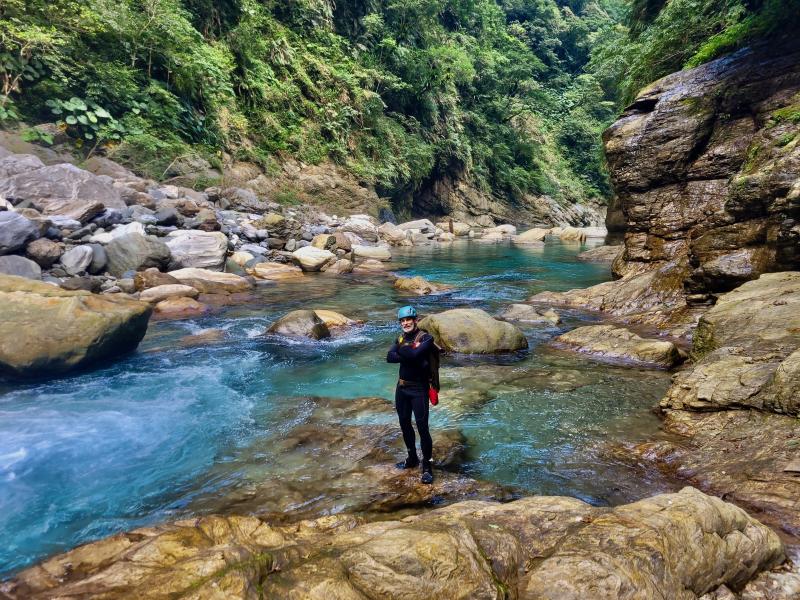
Photo: Tyler Cottenie
Before you head out, make sure you have your river tracing shoes (neoprene with felt bottoms), helmet, wet suit and life jacket, as well as any other day-hike essentials. A waterproof backpack is best for this kind of trip. I only needed the wetsuit inside the Golden Grotto, when I was out of direct sunlight, but even with it on, I was shivering after less than half an hour.
PRISTINE RIVER

Photo: Tyler Cottenie
For the initial walk, you can take a forest trail that follows an open aqueduct built in the 1950s with American funds. We saved that for the return trip and went down to the river first for a more scenic walk. The river water here was a beautiful aquamarine and so clear I was tempted to drink it. There were plenty of places to swim and rocks to jump off along the way.
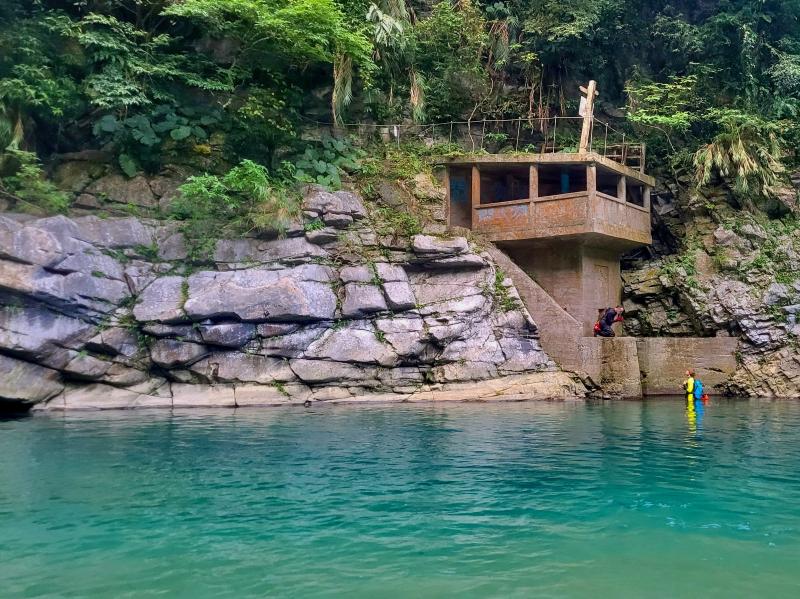
Photo: Tyler Cottenie
Eventually, the forest route and river route meet up at the intake for the Beipu Aqueduct (北埔圳), about one hour upstream. The concrete tower here is structurally sound and makes for great photos, not to mention an excellent diving platform if the water below is deep enough.
After the tower, it’s another hour of scenic walking to the entrance of the Golden Grotto. It really is worth waiting for a sunny day to do this trace, as the sunlit cliffs next to the bright blue of the river are a magical sight you won’t soon forget.
Just before the river makes a 130-degree bend from a western to a southeastern course, a small stream enters from the north. It's easy to miss as the flow is low and sometimes hidden underneath boulders, but this is the way into the Golden Grotto.
Instead of entering this side stream immediately, David suggested we take a break in the main river valley first. This proved wise, as when we finally did start climbing up through the boulders of the side stream to reach the Golden Grotto's entrance pool, we heard small rocks falling right beside us. This is not a place to lounge about for any length of time. Helmets are truly not optional equipment on this walk.
The grotto’s entrance is unmistakable: a wide, tranquil, turquoise pool that draws the eye toward a dramatic, vertical slot extending deep into the mountain behind it. A deceptively small trickle of water spills out of the slot into the pool, giving no indication of the rushing water hidden deeper inside.
INTO THE GROTTO
After swimming across the pool and climbing up the boulders at the entrance, we were transported to another world. A sliver of sky above illuminated the near-vertical walls, textured in myriad ways by the erosion that has been carving out this slot canyon for millennia. The most stunning views here, and the reason for the moniker Golden Grotto, can be experienced near noon in the summer, when the sun is nearly overhead and can shine right down to the bottom of the canyon.
The canyon makes a sharp turn to the right just ahead and the stream widens out into another pool. At the far end of the pool we saw water cascading down a three-meter wall of rock and, to our relief, a rope dangling beside the waterfall. Without a rope in place, it's very difficult for an inexperienced river tracer like me to get up this wall.
David would have been able to climb up and set up a rope for us, but for anyone thinking of visiting on their own, be aware that this wall can be a real sticking point. When the water isn't deep, the far right side may also offer a dry route to climb up to the next tier.
After conquering the most difficult rock face of the trip, there was only one more pool and one more cascade to get through to reach the final destination: the Inner Sanctum.
This third pool is flanked by rock walls 15 to 20 meters high that can't even be described as vertical, as they actually slope inward, leaving just a narrow slice of sky above. The only way forward for us was to jump into the water and swim. The pool was a few meters deep, but so crystal clear that we could easily see down to the blue-tinted bottom under our feet. You won't find water more beautiful than this anywhere in Taiwan.
REACHING THE INNER SANCTUM
Then came the part I was most apprehensive about: the final cascade. Having little experience in river tracing, scaling a wet four-meter wall while getting blasted with water from above was intimidating. This was the main reason I did not want to attempt the Golden Grotto without an experienced guide like David.
As it turned out, there was a rope in place and the water flow wasn't strong enough to push me backward, at least on that day. Even without a rope, I believe I could have made it up, as the wall isn't actually vertical here and there are a multitude of ledges and holes to use as footholds. Still, I'm very glad I had a helmet on that day,
Upon reaching the top, we high-fived and stared up at the beauty of the Inner Sanctum. From an opening in the canyon high above, sunlight, wind and water poured down into the cavernous space. The roar of the water echoed off the walls, whose algae-covered rock glistened in green and red. The sounds, the colors, the wind and spray in our faces: this was sensory overload in the best way possible.
After exploring the nooks and crannies of the Inner Sanctum, the adventure still wasn’t over. On our way back out, we forewent the ropes and just jumped from the top of each waterfall into the pools below. The adrenaline rush finally ended when we took our last jump out of the canyon into the entrance pool.
After last year’s earthquake, a lot of gravel washed down into the canyon and the pools aren’t deep enough for diving at the moment. However, this could change again in the future. At the very least, the walk in and out of the canyon is now a lot easier and safer, with the scenic value undiminished.
This hike is not for beginners. Plan on 7 to 8 hours round trip with breaks, and do not attempt this if there is heavy rain in the forecast. Bring the proper equipment and an experienced tracer, or hire a local guide. For more details and photos, visit The Map Room’s description at: www.maproomexplorers.com/post/goldengrotto.

It’s always a pleasure to see something one has long advocated slowly become reality. The late August visit of a delegation to the Philippines led by Deputy Minister of Agriculture Huang Chao-ching (黃昭欽), Chair of Chinese International Economic Cooperation Association Joseph Lyu (呂桔誠) and US-Taiwan Business Council vice president, Lotta Danielsson, was yet another example of how the two nations are drawing closer together. The security threat from the People’s Republic of China (PRC), along with their complementary economies, is finally fostering growth in ties. Interestingly, officials from both sides often refer to a shared Austronesian heritage when arguing for
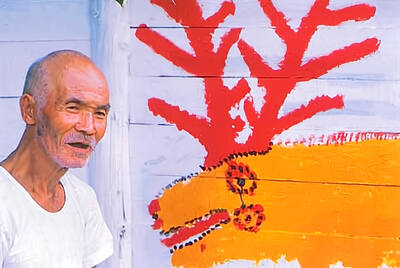
Nov.10 to Nov.16 As he moved a large stone that had fallen from a truck near his field, 65-year-old Lin Yuan (林淵) felt a sudden urge. He fetched his tools and began to carve. The recently retired farmer had been feeling restless after a lifetime of hard labor in Yuchi Township (魚池), Nantou County. His first piece, Stone Fairy Maiden (石仙姑), completed in 1977, was reportedly a representation of his late wife. This version of how Lin began his late-life art career is recorded in Nantou County historian Teng Hsiang-yang’s (鄧相揚) 2009 biography of him. His expressive work eventually caught the attention
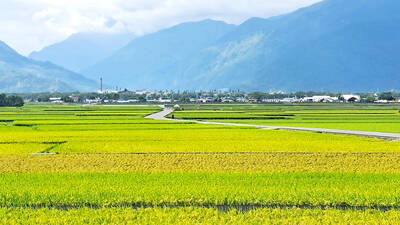
Late last month the Executive Yuan approved a proposal from the Ministry of Labor to allow the hospitality industry to recruit mid-level migrant workers. The industry, surveys said, was short 6,600 laborers. In reality, it is already heavily using illegal foreign workers — foreign wives of foreign residents who cannot work, runaways and illegally moonlighting factory workers. The proposal thus merely legalizes what already exists. The government could generate a similar legal labor supply simply by legalizing moonlighting and permitting spouses of legal residents to work legally on their current visa. But after 30 years of advocating for that reform,
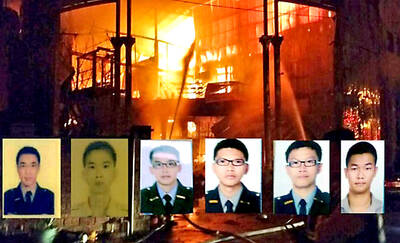
Cheng Shao-shu (鄭少書) was advancing alone through a smoke-filled corridor in Miaoli, when he suddenly realized he couldn’t breathe. The firefighter tore off his mask, only for the hot air to scorch his lungs. Gasping, he snapped the mask back on and scrambled out of the inferno. Cheng says he survived the fire only because he was near a door; had he been deeper inside the building, he wouldn’t have made it out. “It may not be the toughest job, but it is certainly one of the most dangerous,” Cheng says. Over the past two decades, 77 firefighters have died in the